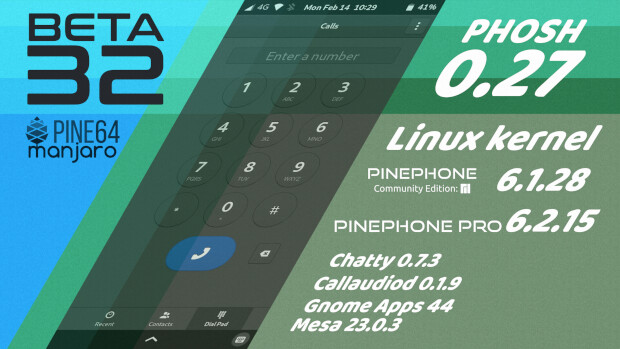Manjaro ARM Beta32 of Phosh for PinePhone!
The Manjaro ARM project is proud to announce our Thirtysecond BETA release for the PinePhone running Phosh!

Those images run the 6.1 or 6.2 kernel from Megi.
Features:
- Camera app with access to back and front camera, including autofocus
- Auto-Rotate function and manual rotate
- Welcome wizard for easy setup of the device
- We have now a working Torch in the quick-access-menu
- Prime phone functions working, including resume from deep-sleep and free speaking
- Recording of audio works
- Most applications got added to
scale-to-fit - Haptic feedback functions are given
- Optimized keyboard layout for terminal
- Maps working with geolocate
- Volume buttons working
- Sensors fully functional
- Easy access to Bluetooth, Wlan, Rotate and Mobile functions via quick settings
- Default branch is
arm-stable. This can be changed by editing/etc/pacman-mirrors.conf - usage of callaudiod for better audio experience with calls
- This image uses a Crust enabled uboot (Pinephone only)
Changes since Beta 31
-
Kernel is now at 6.1.28 for the Pinephone.
- this includes additional upstream patches.
- for the PinePhonePro we updated the kernel to 6.2.15
- Chatty is at 0.7.3
- callaudiod got renewed to 0.1.9
- feedbackd is at 0.2.0
- Gnome Apps got updated to latest 43 or 44 series
- Firefox is renewed to 112.0.2
- phosh is at 0.27.0, phoc at 0.27.0 and phosh-mobile-settings at 0.27.0
- pipewire got renewed to 0.3.70
- Mesa got updated to 23.0.3
- Pamac is at 10.5.1 and libpamac at 11.5.3
A detailed list of package changes can be found here.
Currently broken:
- GPS may not work as it should
Known issues
- During a Call the Mic can’t be muted on Pinephone and PinephonePro
- UI becomes unresponsive after a while.
- Doing a recording may result in noisy audio savings
- Lots of apps are still missing or are not mobile friendly yet.
Download:
About the device:
PinePhone:
Perhaps you’re in a line of work where security is a must, or a hard-core Linux enthusiast, or perhaps you’ve just got enough of Android and iOS and you’re ready for something else – the PinePhone may be the next Phone for you. Powered by the same Quad-Core ARM Cortex A53 64-Bit SOC used in our popular PINE A64 Single Board Computer, the PinePhone runs mainline Linux as well as anything else you’ll get it to run.
The purpose of the PinePhone isn’t only to deliver a functioning Linux phone to end-users, but also to actively create a market for such a device, as well as to support existing and well established Linux-on-Phone projects. All major Linux Phone-oriented projects, as well as other FOSS OS’, are represented on the PinePhone and developers work together on our platform to bring support this this community driven device.
Order
Pinephones Beta Edition are still on stock. Visit the Pine64 Store
How to install:
Download the image/xz file from the download location. Verify that the download completed successfully.
After that, install Etcher (sudo pacman -S etcher if on Manjaro) and burn the to an SD card (8 GB or larger).
The PinePhone should recognize the SD card as a bootable device and boot from it.
The premade users are:
User: manjaro
Password: 123456
User: root
password: root
Donate!
Please consider supporting Manjaro ARM directly via Patreon, Ko-Fi or Open Collective.
You can also donate to our upstream, which is Arch Linux ARM.
Bugtracker
If you face issues with this editon, please open a new issue on our bug-tracker
Development Changelog
We will list our progress to Beta33 here
- Beta32 (2023-05-27) Download
- based on stable branch
- Bonus (2023-05-29)
- we worked with Megi on DRAM frequency scaling for the Pinephone Pro which saves 0.5W of power!
- Dev (2023-05-30) Download
- based on unstable branch
- Known issue: xdg-desktop-portal-gnome gets installed as a dependency. Remove it as applications may start slower than needed.
-
Gnome Shell and Mutter got updated to 44 series
- most applications are now ported to GTK4
- Kernels got updated to 6.3 series
-
alsa-ucm-conf 1.2.9 included a broken PP UCM config.
- We are using the working from Mobian still
- Firefox is renewed to 113.0.1
- Megapixels gained support for newer kernels
- Python got updated to 3.11
- Systemd is now at 253.4
- Dev (2023-05-30) Download
- based on unstable branch
- Kernel got updated to 6.3.5
- fixed regression in Pinephone power consumption during sleep (touchscreen was not disabled properly, consuming a lot of power)
- added DRAM reclocking support to Pinephone Pro (needs Rockchip TPL/TF-A)
- updated uboot to 2023.07-rc2 from megi-branch
- we are using proprietary Rockchip TPL/TF-A to have optimized power-management which saves 0.5W of power.
- Phoc got updated to 0.28.0
- Phosh and Phosh-Mobile-Settings got updated to latest git-master commits to match phoc
- Gnome-Control-Center is at 43.6
- Megapixels now supports newer kernels and got updated to 1.6.1
- Dev (2023-05-02) Download
- Dev (2023-05-06) Download
- based on unstable branch
- updated uboot to 2023.07-rc2 from megi-branch
- default firmware uses FOSS TF-A
- we added uboot-pinephonepro-rockchip using proprietary Rockchip TPL/TF-A to have optimized power-management which saves 0.5W of power.